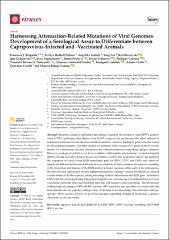Harnessing Attenuation-Related Mutations of Viral Genomes: Development of a Serological Assay to Differentiate between Capripoxvirus-Infected and -Vaccinated Animals

View/
Date
2023Author
Berguido, Francisco J.
Chibssa, Tesfaye Rufael
Loitsch, Angelika
Liu, Yang
Krstevski, Kiril
Djadjovski, Igor
Tuppurainen, Eeva
Petrović, Tamaš
Vidanović, Dejan
Caufour, Philippe
Settypalli, Tirumala Bharani K.
Grünwald-Gruber, Clemens
Grabherr, Reingard
Diallo, Adama
Cattoli, Giovanni
Lamien, Charles Euloge
Metadata
Show full item recordAbstract
Sheeppox, goatpox, and lumpy skin disease caused by the sheeppox virus (SPPV), goatpox
virus (GTPV), and lumpy skin disease virus (LSDV), respectively, are diseases that affect millions of
ruminants and many low-income households in endemic countries, leading to great economic losses
for the ruminant industry. The three viruses are members of the Capripoxvirus genus of the Poxviridae
family. Live attenuated vaccines remain the only efficient means for controlling capripox diseases.
However, serological tools have not been available to differentiate infected from vaccinated animals
(DIVA), though crucial for proper disease surveillance, control, and eradication efforts. We analysed
the sequences of variola virus B22R homologue gene for SPPV, GTPV, and LSDV and observed
significant differences between field and vaccine strains in all three capripoxvirus species, resulting
in the truncation and absence of the B22R protein in major vaccines within each of the viral species.
We selected and expressed a protein fragment present in wildtype viruses but absent in selected
vaccine strains of all three species, taking advantage of these alterations in the B22R gene. An indirect
ELISA (iELISA) developed using this protein fragment was evaluated on well-characterized sera from
vaccinated, naturally and experimentally infected, and negative cattle and sheep. The developed
wildtype-specific capripox DIVA iELISA showed >99% sensitivity and specificity for serum collected
from animals infected with the wildtype virus. To the best of our knowledge, this is the first wildtypespecific,
DIVA-capable iELISA for poxvirus diseases exploiting changes in nucleotide sequence
alterations in vaccine strains.
